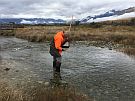Tuesday 3 April
Braided Rivers of Ō Tū Wharekai
Follow Brad Edwards onto an “island” between two braids of the Hakatere (Ashburton) River and find out what makes these river systems so unique. I wonder how they are formed in the first place.
Not all Wetlands are Wet
Brad Edwards takes you into an ephemeral tarn, also known as a kettle hole. How were these wetlands made? And why is this a wetland if there is no water in it?
Types of Wetlands
You are now with Juzah Zammit-Ross at Māori Lakes. Hear Juzah describe the variety of wetlands around New Zealand and some the birds and animals that live in them.
Helping Wetlands So They Can Help Us
Wander further into the raupō and amongst the pūkio at Māori Lakes. Get some tips for helping to look after or restore a wetland near you.
Wednesday 4 April
1. The People of Ō Tū Wharekai
You are at Māori Lakes with Tewera King from Te Rūnanga o Arowhenua. Tewera discusses the value of connecting with places of personal value. He also paints a picture of what his ancestors used this area for in the past.
2. Vanishing Wetlands
Explore the old buildings of Hakatere Station. Catch up with Brad Edwards and hear about how early pioneer land development often meant bad news for the many wetlands that once featured all around Aotearoa. But is it all bad news?
3. Once Were Forests
Near Lake Heron/Ō Tū Roto, lies a remnant patch of kowhai trees. Juzah Zammit-Ross gives you an idea of how this area may have once looked, and how DOC is using these trees to help with replanting efforts.
4. Restoring Ō Tū Wharekai
See the early results of locally sourced seeds being used for wetland restoration. Get advice and encouragement to begin or contribute to wetland restoration in your area.
Thursday 5 April
1. The Weird and Wonderful Wrybill
You are at the upper Rangitata River with Brad Edwards and his friend Scruffy. Find out about this special braided river bird called the wrybill, also known as ngutu parore. Braided rivers can be harsh environments - I wonder how they are adapted to live in them.
2. Managing Predators
Many of New Zealand’s wetland birds are threatened. Why is this? How are DOC working to reduce their threats and increase their numbers? Brad Edwards explains why some wetland birds are so low in numbers and what is being done to help them.
3. Predator Surveillance
What is a tracking tunnel and how do they work? What can they tell us about the animals living in environments such as wetlands? Information is key to native animal restoration. In this video, Juzah Zammit-Ross shows you two tools they use to get this information. You will also get an idea about how to set up your own tracking tunnel at school or home.
4. Curious Kāmana
You will never see an Australasian crested grebe/kāmana on land. But you might be lucky enough to see one at a lake such as Lake Clearwater/Te Puna a Taka. Find out more about this unique wetland bird and the special adaptations it has.
For help and more information about LEARNZ videos, go to Help with Videos in the LEARNZ Support section.
Video question sheet - Word (31k) | PDF (217k) | Google Doc to use for each video (based on SOLO Taxonomy).




